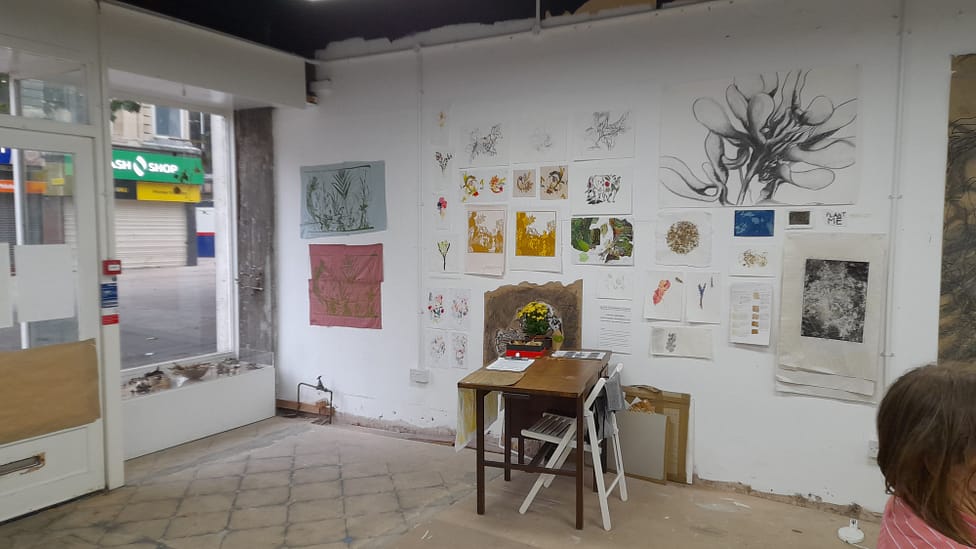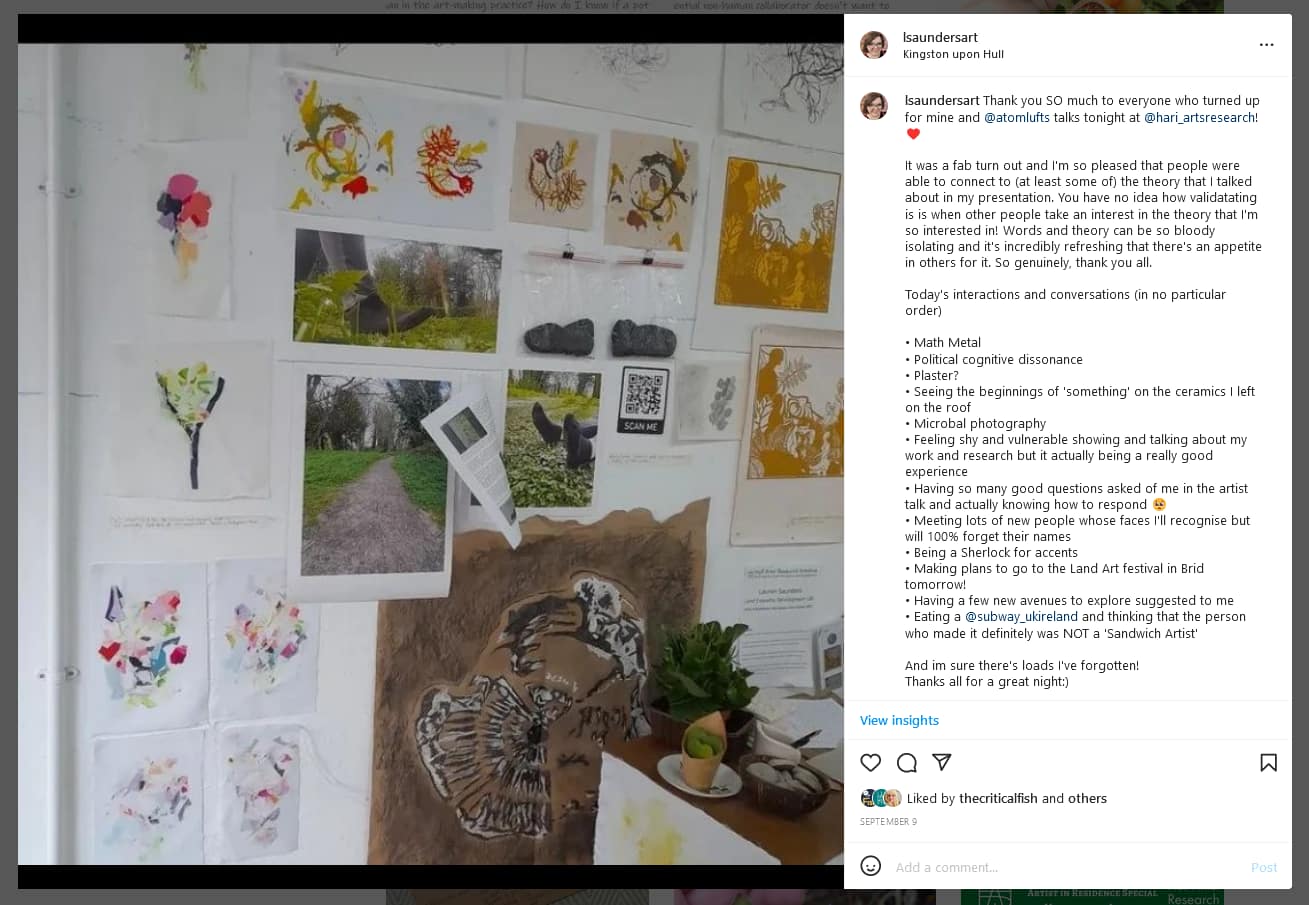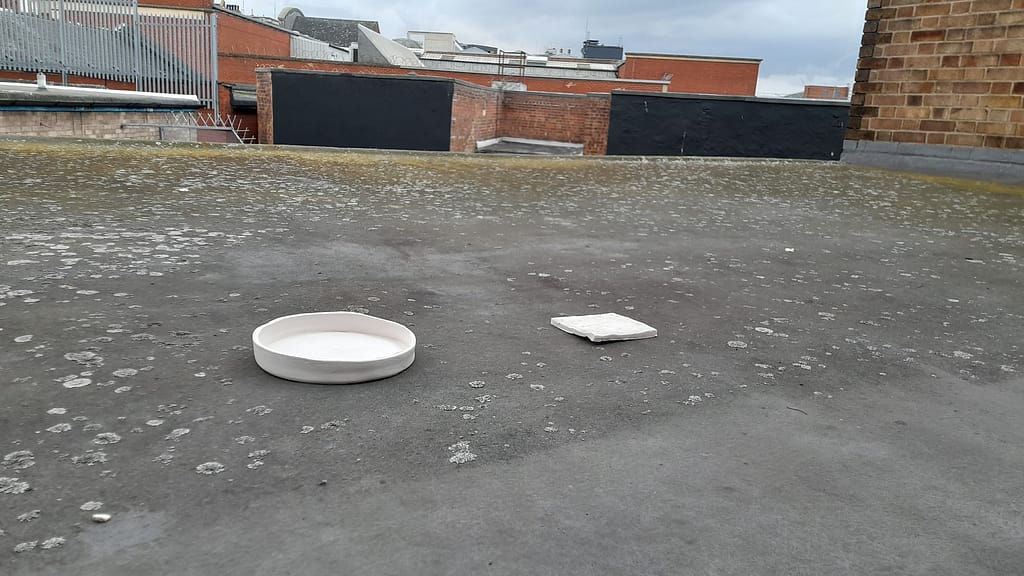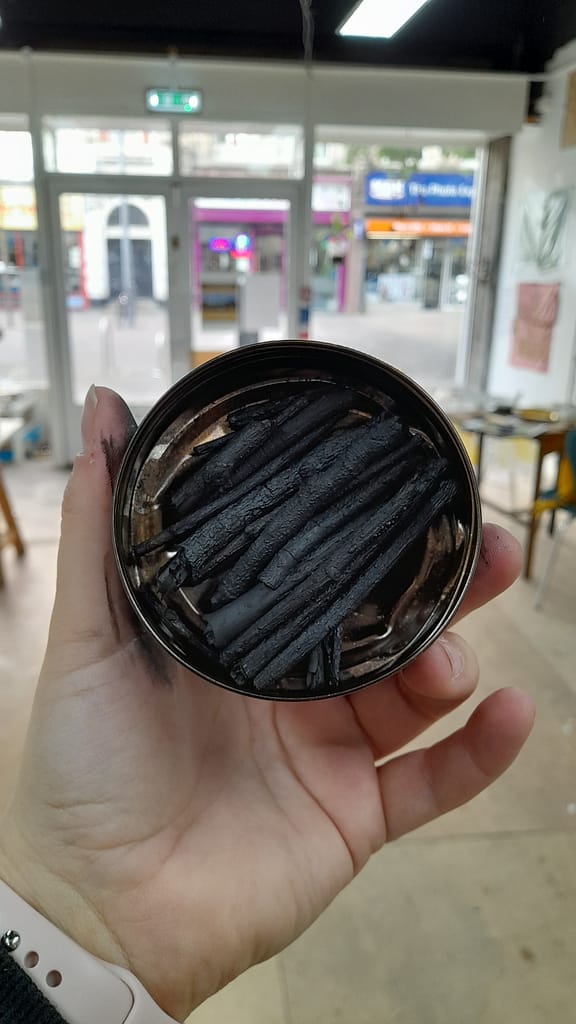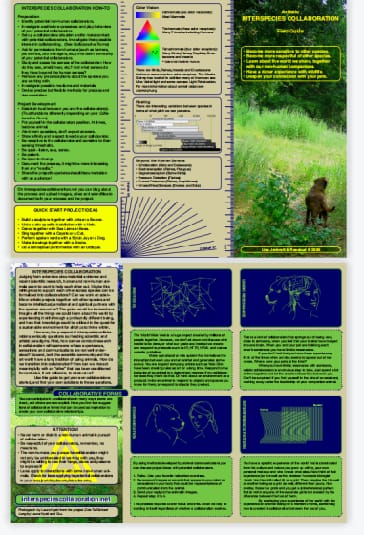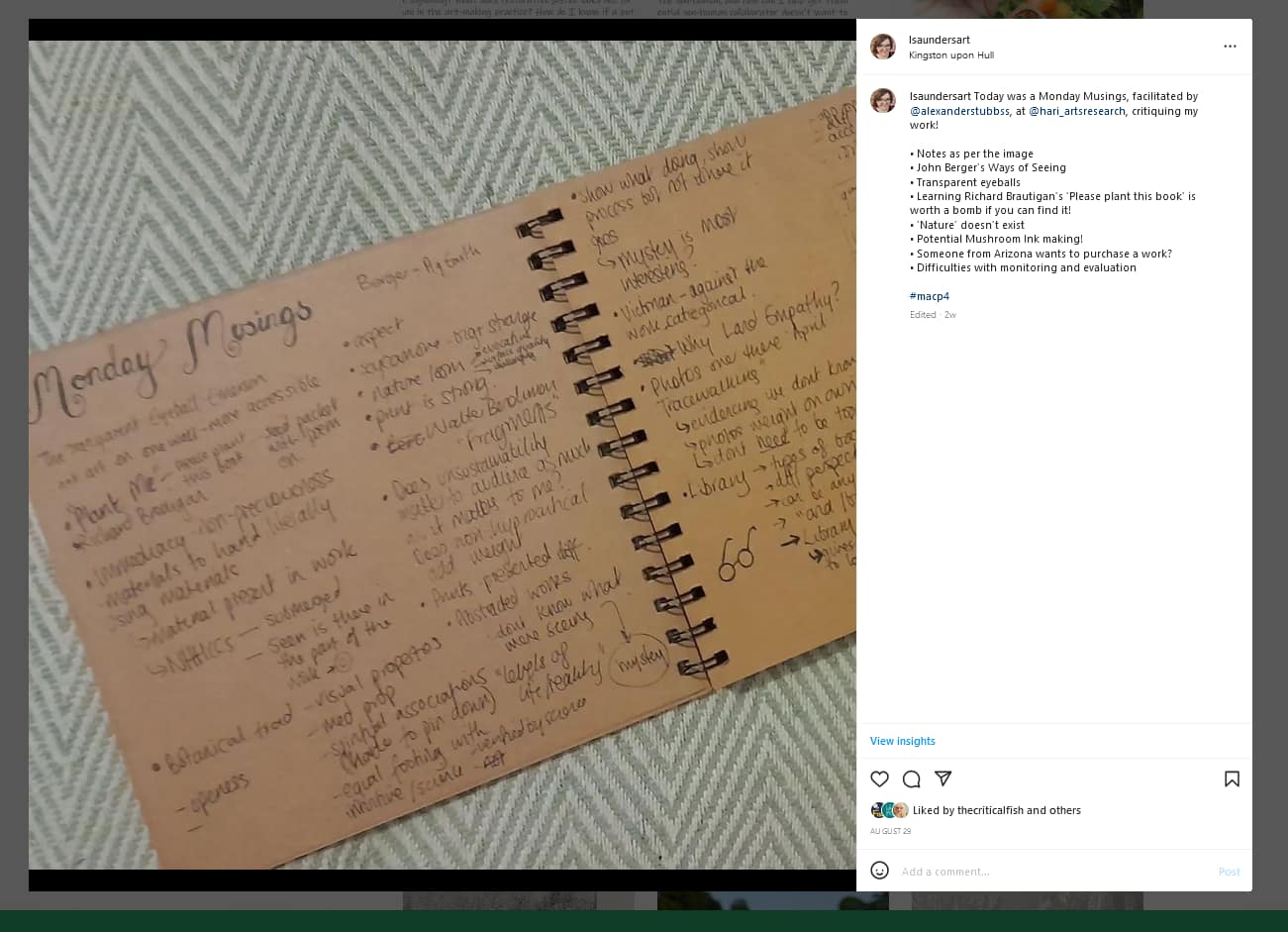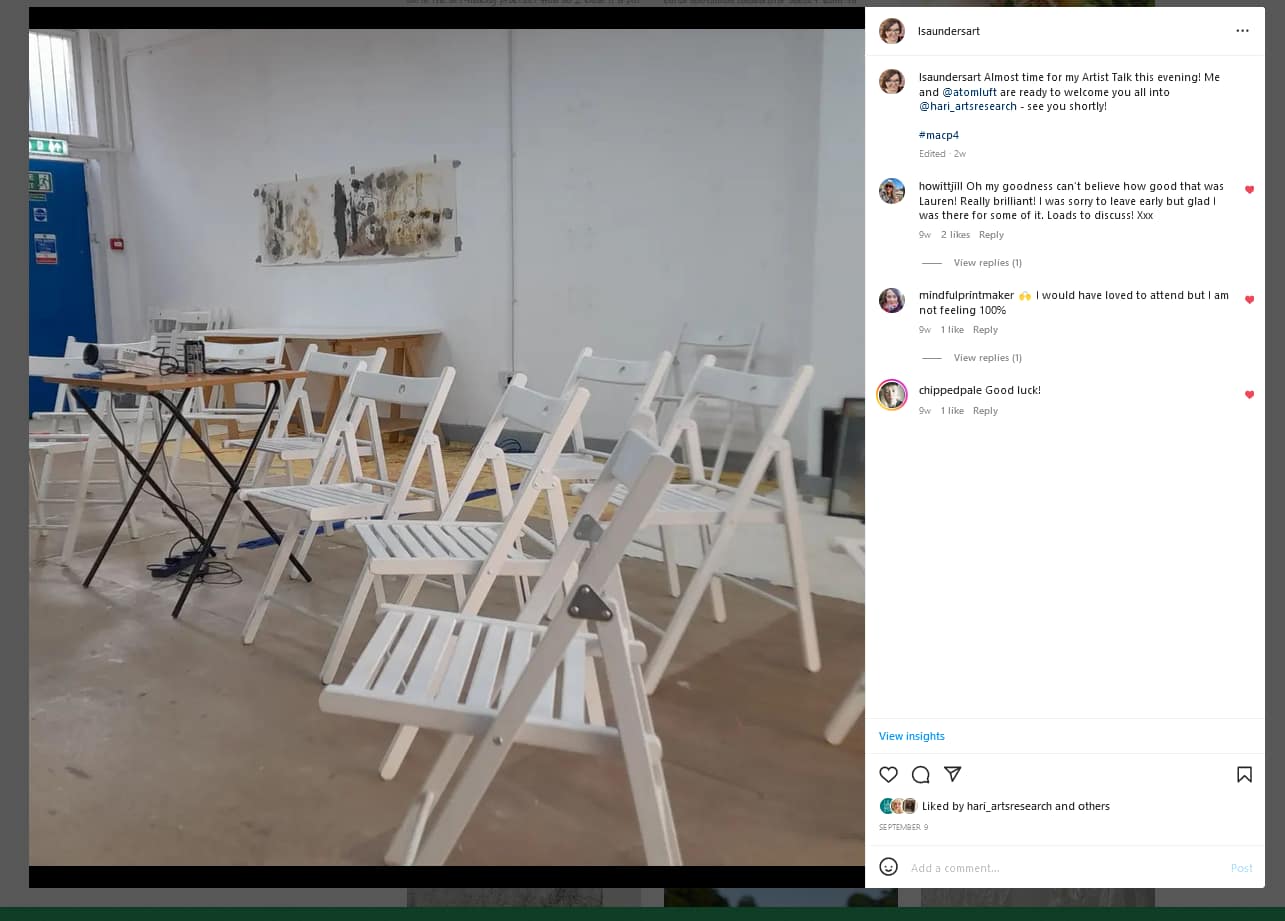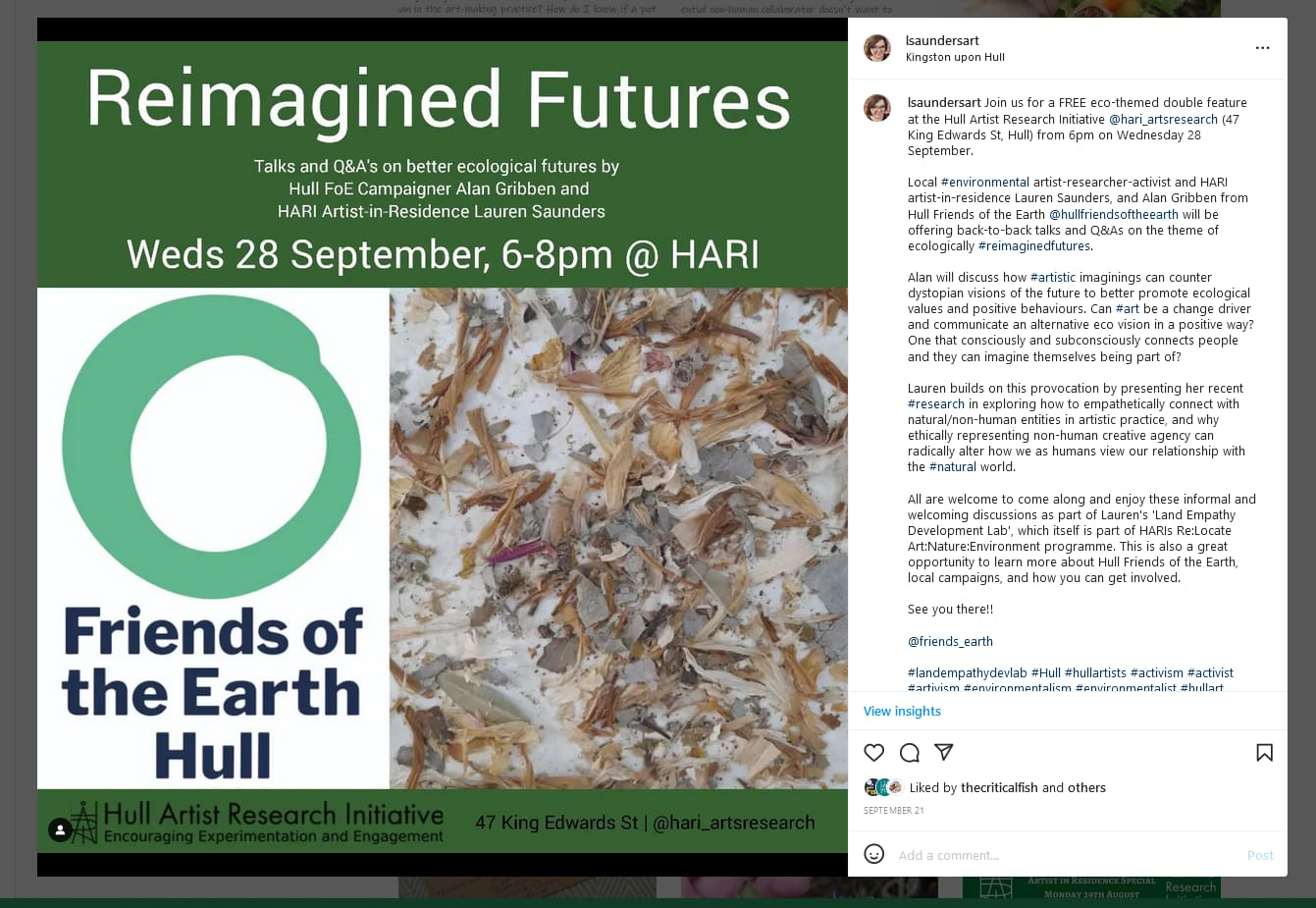CONNECTS TO THEORY CODES: GDGS01, DA01, EE01, EPP01, HNH01, HNH02, SP01, STEK01 and STEK02 (see Meta-post)
Between 10 August and 16 October 2022, I was the key artist-in-residence at the Hull Artist Research Initiative as part of the organisations RE:LOCATE: Art, Nature, Environment programme. I was in there exploring practice alongside shorter-term AIRs Jessie Davies, Martin Lewsley, Dionne Ruffy and Monika Dutta.
I was offered the opportunity by the wonderful HARI Director and artist-in-her-own-right, Sarah Pennington. My personal intention going into the residency was to address some of my own doubt and anxieties about sharing my work. I wrote this as part of my statement for HARI, which was shown in the window and next to my work:
“My intention for my residency at HARI is to – at it’s core – is about reciprocity… it’s an opportunity for others to share in my learning, but also for me to deepen my understanding encounter new contexts and perspectives through dialogue with other artists, climate thinkers and the wider community. Within this, I hope to test out various empathy-increasing practices and research-sharing activities with audiences, communities and my peers. I truly hope my work-in-progress serves as a prompt for conversation, thinking and transformation.”
In the context of Module 4 of my MA, however, this residency was an exercise in informing and contextualising the developing my practice, as it helped me to identify and explore ways of presenting ideas and theory to new and existing audiences, whilst also making connections with other practitioners who also have an interest in this sort of stuff.
In no particular order, here I offer an evaluative, critical reflection of residency methodologies, choices, experiences and observations to assess that which are most appropriate for me to take forward within practice, and why.
Exhibiting work in a non-traditional/meanwhile space on a commercial high street
HARI is a meanwhile space, meaning that the arts org can use an empty commercial retail unit until a business comes along and decides to rent it. I showcased some of my artwork in this meanwhile space, which has a very different feel than exhibiting work in a more traditional, ‘white cube’ arts space.
The space was visited by ‘the art crowd’ as well – predominately artists who already had a connection to the space/me/other AIRs, but – as far as I’m aware – the culture-vultures who soak up the cultural offer from the bigger institutions… possibly because those other places are more established with a well-announced/marketed programme (in contrast to HARI, which works very dynamically and doesn’t have the resources to promote things in that way). Despite the white walls, I appreciated that the ‘rawness’ and ‘scruffiness’ of the space helping to reduce the barrier of ‘I don’t belong here’ commonly experienced by non-traditional audiences in traditional gallery settings – lots of people just walked in randomly off the street (sometimes wondering if we were a shop), and were people who I don’t typically see during my day-job at Humber Street Gallery (a contemporary art gallery). I value this on an accessibility and inclusion perspective.
However, work shown in a fancy art gallery is a short-hand for ‘respect this artist, we think their work is worthy of our precious, fancy walls’ – which greatly contributes to the accumulative clout that professional artists need to show funders, other galleries, and so on as they grow in their careers. This isn’t to say that fancy galleries aren’t trying to be inclusive and accessible, but there is a barrier to entering those kinds of spaces to an awful lot of people, and they are typically accessed by artists, creatives and culture-vultures.
The choice of where to present work developed in my Major Project is key to the audiences I’m wanting to reach. Do I want to spread the word as far as possible? Engage non-traditional audiences? Or do I need to build up professional art-industry visibility and respect? Or… is there an in-between option? I can’t make a decision on this yet, but it’s interesting food-for-thought.
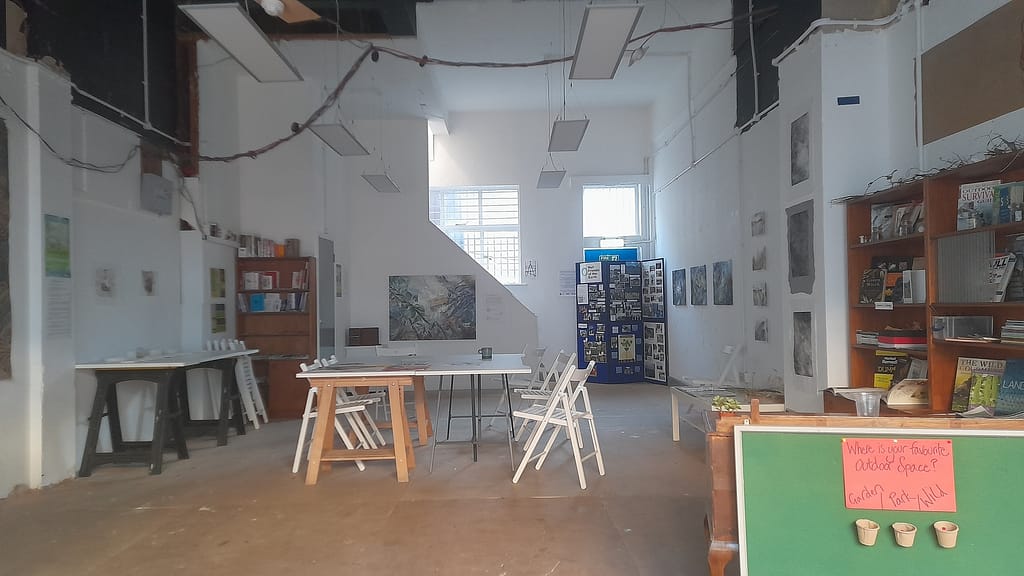
Window displays/visibility
The greenery in the window caught people’s eye, before peering in to see what it was all about. I wonder if it’s because it was something that passersby can relate to – through gardening or a simple enjoyment of nature, perhaps? I also wondered if there was something about a flash of eye-level plant matter in an otherwise pretty grey, concreted, urban space. To link this with Nature Connectedness research (Lumber et al, 2017), encountering green space has a restorative effect on the human parasympathetic nervous system (van den Berg et al, 2015). I know it’s a stretch to call what was in the window a ‘green space’, but perhaps there’s something there to tap into.
If I were to exhibit in this space again, or anywhere where I’m trying to grab attention from random audiences for my Major Project, I think plants in the window would be an effective way to connect audiences to nature (and to my work) before even entering the door. And as we know, connecting to nature is what needs to happen to develop empathy and dutiful moral action (Kala, 2017; Kim, 2016; Nelson, 2013, cited in Blaeser, 2020; Taylor, 2011).
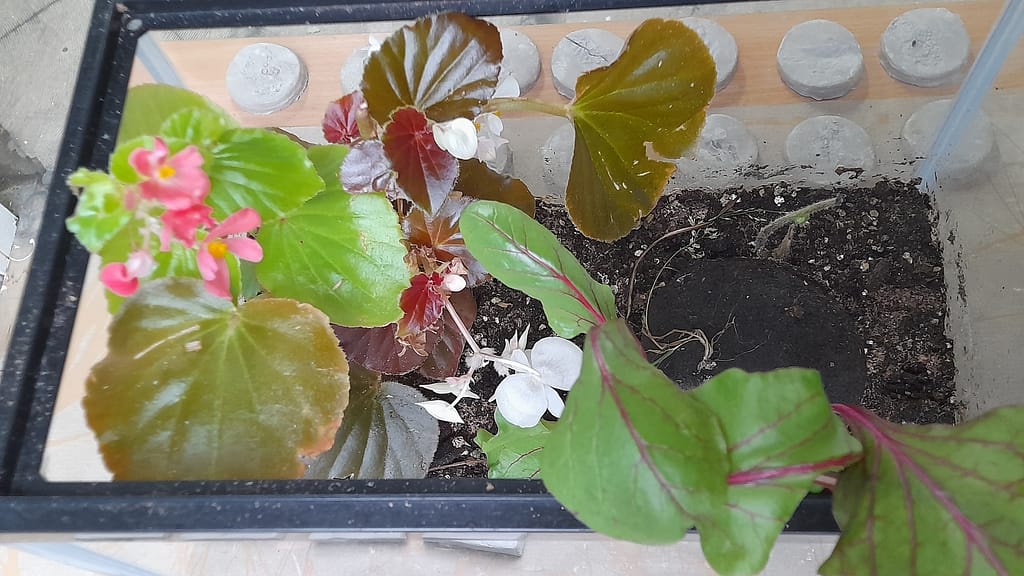
Studio pin-up vs carefully curated displays, WIPS vs finished works
I purposefully put loads of work up on the walls, all over the place, barely edited/curated, in a haphazard (albeit presentable) way using tape and blu-tak (no frames!). These were WIPs and tests and I wanted to communicate that – I didn’t want the walls repainted before pinning up (I wanted the pencil marks and mess from previous AIRs) for that reason. I wanted to also offer that messy studio reality that few people see, and I wanted people to feel comfortable touching and exploring my work (including the sketchbooks on the table). This was in contrast to Jessie Davies paintings, which were all beautifully presented on mirror plates – with lots of white space (on the repainted white walls) surrounding them – which of course, is coded with ‘Don’t Touch!’. Lots of people thought Jess’ work was my work – like I was showing prep works and final works.
Saying that, the general assumption – especially after Jessie’s were taken down – from basically EVERYONE was that what I had on the wall were all final works. In reality, I didn’t really have final works, but the ones I considered ‘most final’ were my HNHCC tests – which were surrounded by a sea of white space on a small wall dedicated just to them. As above, this presentation is code for ‘look at me, value me’. I don’t think it was conscious to place them like that, it’s just what I did (conditioned!)
In hindsight, I wish I layered and unordered the work I had on the walls more – so it actually was chaos. I think it would’ve provided greater energy and contrast between the HNHCCs… even though it’d be confusing for audiences as there would be a lack of visual narrative. I think when I was pinning up – which I did in a hurry – I think I was just defaulting back to neat and orderly ways of presentation. Which is fairly neat, but not very interesting…
I think the haphazard studio approach works best if the purpose is to show the creative research process (HARIs remit), whereas final works – which you might want to ascribe more value/audience attention to – do work better in a clearer space (less distraction). But…
There is something for me though about this holistic approach to presentation that is reflective of Western relationships to nature; the dissection of plants to understand their compounds, or the removal/displacement of the non-human from their natural environment is very much a Western, categorical, dualistic and reductive worldview (Coleman, 2016; Ingold, 2000; White, 1994a) way of doing things. Research/developments and final works can be one and the same, and if we are to practice-practically what we preach in theory, perhaps I shouldn‘t try to separate the two? Is there a way to invert or challenge the coding behind cultural valuation? Can artistic presentation be a metaphor for challenging anthropocentric value-based systems?
I know I’m not coming up with many concrete decisions to take moving forwards yet into my Major Project… but I don’t think I can until I have a clearer idea of what I want to do. Philosophising helps though – it gives me greater considered choice when it comes to deciding on what I’m doing!
Research Practice Statement and Artist Statement
I wrote a research practice statement, which I don’t think is an official thing that anyone else does, but I wrote one out of necessity and put up on the wall in HARI because it offered further context to me work (overexplaining?). I actually devised it to help me think through another project I was involved in – the Leeds Art University UKRI PostGrad Research-in-Practice project over summer. I was invited to be an researching-artist and mentor, and part of that was giving a presentation on my work, and what research looked like to me (at least, that was my interpretation of what I was meant to do). I really struggled to articulate how what I’m doing is research, and so I wrote a thing of ‘I statements’ that sum up my approach, values and methodologies as an artist. By god, it was a helpful, confidence-building, validating exercise. I will be using this practice to help me identify my approach to practice/research throughout my life, as my artistic focus/priorities shift. I think a bullet-pointed research statement offers rich context in a relatively simple, accessible way – it’s much, much better than a flowery, arty bollocks artist statement. One visitor:friend commented on my Research Statement over anything else in the room, saying it was brilliant, incredibly interesting, powerful and attested to my character. Which was nice!
I did write an artist statement, and tried to communicate what I was doing and what I’m interested in without confusing or patronising the reader (I hope). There’s complex theory/references in there, but I think its matter-of-fact and friendly. It might be a bit arty bollocks to some people, no doubt, but there’s no flowery language that says a lot of something about nothing. There are parts of the statement that read a little like a letter, which I didn’t notice at the time but I actually really like. It’s more intimate, almost inviting the reader to be involved in the conversation around the themes as opposed to a passive receiver of STATEMENT. That’s nice, I might develop my artist statement to read like a letter. A letter from who? From me? Or a non-descript, non-human entity? Is is arrogant to position myself as the voice of the non-human? Should the non-human have its own presence in an artist statement, since they’re also collaborating on me with some of the work?
In terms of my Major Project presentation, the type of statement(s) presented will need to meet the context of the space, the anticipated audiences, and the work. A bullet point statement, and a collaborated-upon, artist statement:letter could be really interesting to move forwards with…
Instagram Diary
I started this off with good intentions, but just never kept it up – learnt that it’s perhaps unreasonable to maintain over a long period of time. Every time I was in the space, I intended to do an IG post recounting the interactions, observations, comments and experiences had during that visit.
For the times I did do it, it was really valuable in remembering the conversations, sparks of ideas, potential avenues to explore and so on that I know I would forget really quickly. I think it would be worth attempting to repeat in future – say, during my MA exhibition – but I find it easier to journal on paper, rather than digitally. But the sharing element of it, and acknowledging others input into my thinking, feels affiliative and kind and more my style. I think the extra effort to remember to do a digital journal is worth it.
Losing Artwork
I placed some artworks on the roof of HARI – 2 ceramic pieces, and a print – to expose them to the elements. What I loved is that I sensed a storm was brewing, put them out, and then about five minutes later it started howling out. Skills intuition strong, this one. A few weeks later I went up to retrieve the works – I brought the print indoors as it had come loose from its fixings and had flown into a mysterious roof river of sludge, which left a visually and intellectually appealing effect… so I felt that that one was done. The two ceramics pieces were heavy, and starting to demonstrate the impact of the rain and sun – namely, little holes were appearing and it was developing a green tinge. Beautiful. HOWEVER. I went up a few weeks later and they had DISAPPEARED!
Could the wind have blown them off? Nah, it was protected by walls on 3 sides and they’re relatively heavy ceramic pieces, and if they’d blown off, there would be shattered ceramic all over the car park below. Could a bird have picked it up and flown off? What, a swallow carrying a ceramic artwork? A five ounce bird could not carry a one pound artwork. It could be carried by an African swallow, maybe, but not a European swallow, that’s my point.
Fact of the matter is, if there was evidence an African swallow flew off with it, I wouldn’t have cared. But all evidence points towards a busy-body security guard or other random person taking what were clearly artworks from behind a barrier that they too would have had to climb over, from a place they had no business to be, without checking with HARI first. It disappeared following human intervention, which really pissed me off. I realise that there’s a risk of losing work when it’s left exposed/out. I don’t mind if the wind takes it, or water surfaces sliding it off and smashing something, or an animal takes it for its bedding… but if a human takes it, who has no invitation to do so, it makes my blood boil. This was two months ago and I’m still really miffed about it. People ruin everything!
In hindsight, there should have maybe been clearer signs, but as no-one else uses the roof, you would have thought there would have been no need to?
In regards to learning ahead of my Final Project, I can’t rely on being able to present everything. I will have to play the numbers game – expose 10 pieces to maybe have 3 that are exhibitable. And never trust a human!
Testing out charcoal-making practice
I’ve been researching a lot into Forest School Activity books (Irving, 2019; Irving, 2022; Worrell and Houston, 2018) with the aim of using some of these activities/skills to reconnect with nature and as forms of Restorative Learning (Prechtel, 2012, cited in Lange, 2017) that I could also share out with others. I wanted to learn how to make my own drawing charcoal – so I used the opportunity for outdoor space (well, a car park) to make some.
It was surprisingly successful, although the tins used were not really ideal (small, circular) – I think I need a big golden syrup tin for airtightness and size. It was a lovely activity though, and something I know would be exciting to do with children and young people in future. I used a small BBQ to light the fire – ideally, I’d have preferred to build a small wood fire but that would not have been safe in a built up inner-city area. If I do some participation/engagement work within my MA, it would be a great to do forest school-esque activities like this where possible, as I believe Restorative Learning is a vehicle for developing Land Ethics.
CRAG Sessions; on Gardening and Nature-based Collaborations
Two Climate Reading Art Group sessions took place at HARI during my residency, CRAG being a monthly(ish) meet-up organised by The Critical Fish, Lockdown Still Lives and Carbon-Borders-Voices. It’s relatively new (only starting in the summer) and is a group that moves between local venues. The idea is that as a group, we explore a text/film/image/podcast (usually relevant to the context in which it’s hosted or what emerged from previous sessions) and share our thoughts and responses to it through conversation. It’s a really effective model to encourage deeper conversation, connecting to other people with similar interests, and, as an artist-researcher, discover new avenues and areas of interest.
One was in response to a podcast that was shared as part of the Rooted Beings exhibition at the Wellcome Collection, the other was Jevbratt’s Interspecies Field Guide (2009) – an influential text for me.
Both were absolutely brilliant discussions and were both great in helping people to explore the themes I was exploring (gardening, land ownership, HNHCCs) in a very different, potentially more accessible way than artwork or images on the wall would allow by themselves. Having artwork in the space that related to the themes of the discussions worked incredibly well, as I could give material examples of how an idea could be illustrated by a work, or how a work could promote alternate perspectives or broader thinking. In the context of my Final Project, if there’s opportunity to host a CRAG in the space, I’d like to do this again as part of any public programming I do. Public programming – in my opinion – is so important for audience development because it not only brings people into the space, it exposes them to ideas, to each other, and makes the work itself less intimidating whilst simultaneously more interesting.
Lauren’s Library
I had a bookshelf in the space, in which I filled with nearly all of my books and magazines on the themes I’m exploring. From my copies of Resurgence magazine, philosophy books, climate books, political books, herbalism books, drawing books, gardening books, activism books, tarot books, magick books… the lot. Lots of people commented on how brilliant and effective a tool this was, as it offered people different routes in, different perspectives to consider, supports the ‘and/both’ approach (1999, cited by Morgain, 2013, p.296), offers further reading for those interested and invites people to sit and spend time. It offered multi-layered and rhizomatic context to the work without it being too complex or ‘in-yer-face’, and allowed people to explore the angles they most connected to. Brilliant.
This is something I’d like to keep doing for future exhibitions (ideally with an armchair or two in tow), including within my Final Project.
Monday Musings Critique
Monday Musings is a monthly event that takes place at HARI. It’s led by local art-writer Alex Stubbs, and the purpose of it is to support cultural crit development. In MM, I invited Alex and the group to critique my work honestly. It was so interesting and so useful to hear what responses were.
Some of the most useful feedback included:
- Querying if the image in the work needs to echo the non-human human collaborator? Yes (but later conversation with another group said it’s a bit too obvious to have them match? I’m thinking the midground is abstracted work?)
- The mystery of abstracted work is interesting – adds to that notion of intuition/magick. Showing what I’m doing, showing the process, but not where it goes next is also mysterious – the mystery is most interesting.
- That my openness and vulnerability is a positive.
- Does unsustainability matter to my audiences as much as it matters to me? Does being non-hypocritical add weight?
- Tracewalking – I don’t need to overexplain it, the images/video stands on it’s own
- Having a Library next to the work was great.
Inviting audiences to share honest feedback about the work has been fantastic in helping me to understand what are the strongest elements of my work, and ways in which to strengthen them. Abstraction = mystery was really interesting, and something I didn’t fully expect as a strength. But it is something I will continue to take forward with me in practice.
An artist talk on The Geopoetics of Drawing
As part of my public programming offer, I delivered an Artist-Talk-come-Research-Presentation on my Literature Review, the Geopoetics of Drawing. I was SO nervous about this, genuinely believing that no-one would find it interesting and that I’d bore everyone, or I’d come across as a know-it-all… and I noticed that I felt a bit of imposter syndrome and really vulnerable in talking about my interest and use in tarot and psychic development…
BOY, WAS I WRONG. The feedback was phenomenal, and I’m still getting complements on it 2 months later. That it was rich, interesting, reassuring for the future, refreshing to see a marrying of the known and the unknown, intellectually and artistically solid, at a level you’d expect to see after a year of PhD research… it was a fantastic response but very overwhelming.
I learnt that there is an appetite for this out there, where I didn’t think there would be one. Artist-Talk-come-Research-Presentations are something I’d do again in future as part of public programming, absolutely – including during the exhibition of my Final Project.
I nearly backed out of doing it with nerves, but I’m glad I didn’t. I found the experience really validating, reassuring and confidence-boosting. I don’t feel insecure about my work anymore.
An artist talk on Human:Non-Human Creative Collaborations / Ethical Art-Making
I gave a second Artist-Talk-come-Research-Presentation on my Module 3 paper too, which took place during Green Week 2022. This wasn’t as well attended as the first one, but it was still brilliant and really valuable. I invited Friends of the Earth (of which I am also an active member) to deliver a presentation to do a sort of double-feature with me. Alan (who made it clear that he’s not ‘arty’ at all) came and talked about how bad aesthetic choices in environmental campaigning / council messaging is either tragic or uninspiring, which doesn’t really offer an attractive alternate vision for the future.
I followed this up by talking about Ethical Art-Making in the context of HNHCCs, and my reimagined vision for the future – that is, one that recognises the non-human as having instrinsic valuations – and how (my) art can help us shift our Western perspective into one that’s more empathetic to the Land.
We then took Q&As and had some really interesting discussion, and I was challenged on the idea that the Earth doesn’t care about our empathy (so?), and it doesn’t need us. Which is a fair point, but I still maintain that my approach is a means to an end (that is, our survival and the survival of wildlife).
What worked fantastically is how both Alan and I brought in different audiences – even though our presentations were very complementary (and some audience members, like me, spanned both worlds already), the environmental campaigners came for Alan’s/FoE talk, the art-lot came for mine. And as such, everyone was exposed to ideas, thinking and actions that they wouldn’t necessarily have encountered if Alan and I did these talks separately. Partnership working and sharing audiences in this way was a real strength, and is absolutely a model I’d look at organising again in future exhibitions (including my Final Project).
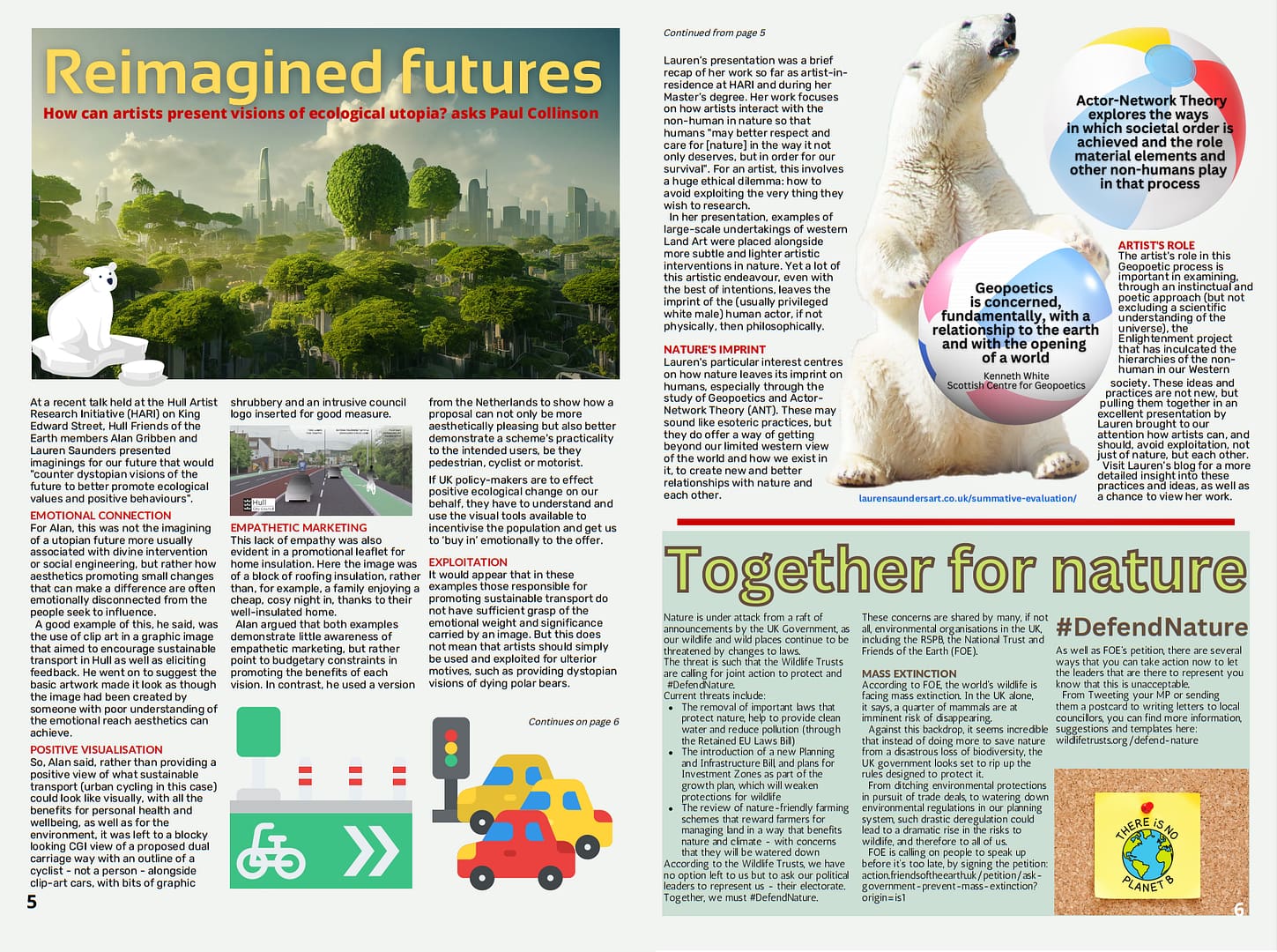
A Mindful Nature Drawing Workshop with the NHS Humber Recovery College
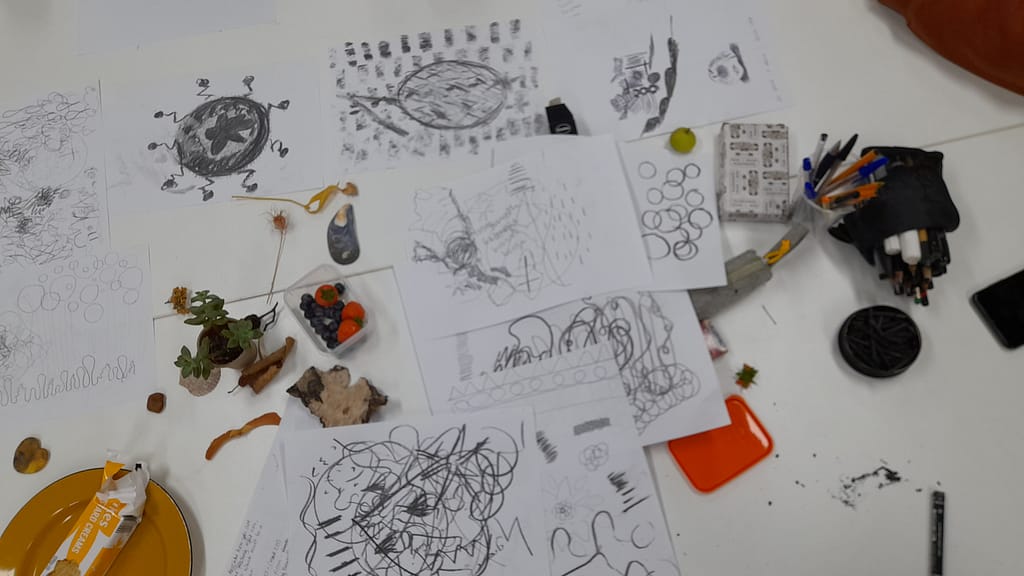
Blaeser, K. (2020) ‘A Cosmology of Nibi; Picto-poetics and palimpsest in Anishinaabeg watery geographies’. In: Magrane, E., Russo, L., De Leeuw, S. and Perez, C. S. (ed.), Geopoetics in Practice, 1st ed. UK, pp. 29 – 47
Coleman, V. (2016) ‘Emergent Rhizomes: Posthumanist Environmental Ethics in the Participatory Art of Ala Plastica’, Confluencia,31(2), pp. 85 – 98
Ingold, T. (2000) The perception of the environment: Essays on livelihood, dwelling and skill. London, England: Routledge.
Irvine, R. (2019). Forest craft : a child’s guide to whittling in the woodland. Lewes, East Sussex: Guild Of Master Craftsman Publictions Ltd.
Irvine, R. (2022). Forest School for Grown-Ups. Chronicle Books.
Jevbratt, L. (2009) Interspecies Field Guide. [ebook] Available at: <http://jevbratt.com/writing/interspecies_field_guide.pdf> [Accessed 26 August 2022].
Kala, C. P. (2017) ‘Conservation of Nature and Natural Resources through Spirituality’, Applied Ecology and Environmental Sciences,5(2), pp. 24 – 34. doi: 10.12691/aees-5-2-1
Kim, J. (2016) ‘Living drawing : Aesthetic teaching for moral artists’, Journal of Moral Education,45(4), pp. 465 – 480. doi: 10.1080/03057240.2016.1239573.
Lange, E. (2017) Riverspeaking: the spiraling of transformative and restorative learning toward kinship ethics. [ebook] Wageningen: Wageningen Academic Publishers, pp.33 – 43. Available at: <https://www.academia.edu/33280576/RiverSpeaking_the_spiraling_of_transformative_and_restorative_learning_toward_kinship_ethics> [Accessed 17 July 2022].
Morgain, R. (2013) ‘The alchemy of life: Magic, anthropology and human nature in a Pagan theology’, The Australian Journal of Anthropology,24(3), pp. 290 – 309. doi: https://doi.org/10.1111/TAJA.12052
Taylor, B. (2011) ‘Gaian Earth Religion and the Modern God of Nature’, Phi Kappa Phi Forum,91(2), pp. 12 – 15
van den Berg MM, Maas J, Muller R, et al. Autonomic Nervous System Responses to Viewing Green and Built Settings: Differentiating Between Sympathetic and Parasympathetic Activity. Int J Environ Res Public Health. 2015;12(12):15860-15874. Published 2015 Dec 14. doi:10.3390/ijerph121215026
White, K. (1994a) ‘On the Highway of History (Extract from Le Plateau de l’Albatros)’ [online] The International Institute of Geopoetics.Available at: <https://www.institut-geopoetique.org/en/founding-texts/132-on-the-highway-of-history> [Accessed 1 December 2021].
Worroll, J. and Houghton, P. (2018). A year of Forest School : outdoor play and skill-building fun for every season. London: Watkins.


